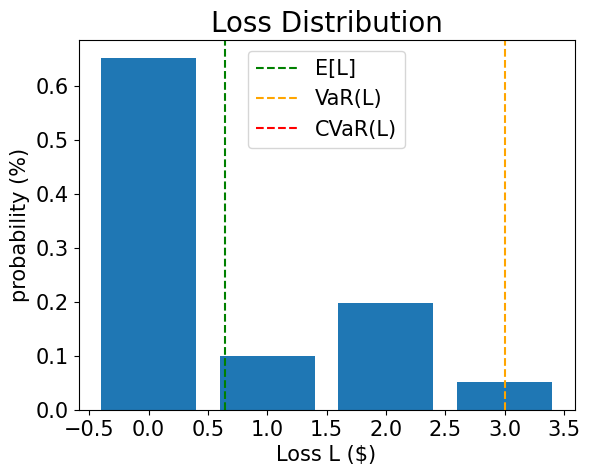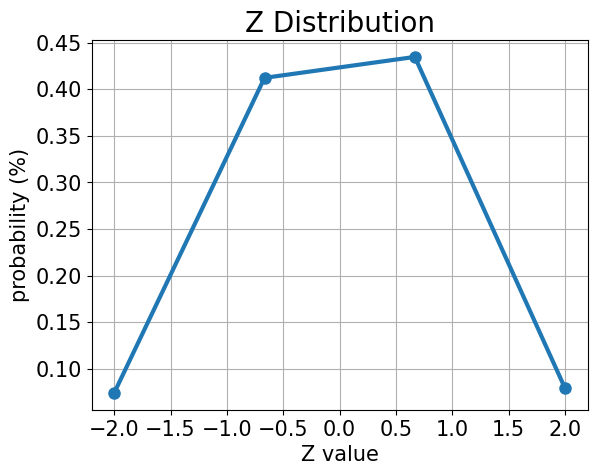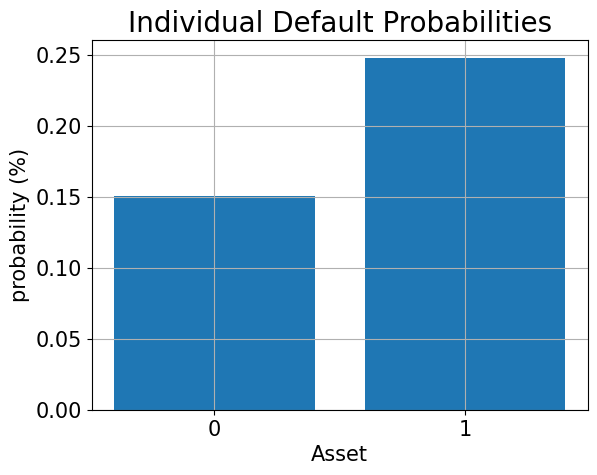Note
This page was generated from docs/tutorials/09_credit_risk_analysis.ipynb.
Credit Risk Analysis#
Introduction#
This tutorial shows how quantum algorithms can be used for credit risk analysis. More precisely, how Quantum Amplitude Estimation (QAE) can be used to estimate risk measures with a quadratic speed-up over classical Monte Carlo simulation. The tutorial is based on the following papers:
Quantum Risk Analysis. Stefan Woerner, Daniel J. Egger. [Woerner2019]
Credit Risk Analysis using Quantum Computers. Egger et al. (2019) [Egger2019]
A general introduction to QAE can be found in the following paper:
The structure of the tutorial is as follows:
[1]:
import numpy as np
import matplotlib.pyplot as plt
from qiskit import QuantumRegister, QuantumCircuit
from qiskit.circuit.library import IntegerComparator
from qiskit_algorithms import IterativeAmplitudeEstimation, EstimationProblem
from qiskit_aer.primitives import Sampler
Problem Definition#
In this tutorial we want to analyze the credit risk of a portfolio of \(K\) assets. The default probability of every asset \(k\) follows a Gaussian Conditional Independence model, i.e., given a value \(z\) sampled from a latent random variable \(Z\) following a standard normal distribution, the default probability of asset \(k\) is given by
where \(F\) denotes the cumulative distribution function of \(Z\), \(p_k^0\) is the default probability of asset \(k\) for \(z=0\) and \(\rho_k\) is the sensitivity of the default probability of asset \(k\) with respect to \(Z\). Thus, given a concrete realization of \(Z\) the individual default events are assumed to be independent from each other.
We are interested in analyzing risk measures of the total loss
where \(\lambda_k\) denotes the loss given default of asset \(k\), and given \(Z\), \(X_k(Z)\) denotes a Bernoulli variable representing the default event of asset \(k\). More precisely, we are interested in the expected value \(\mathbb{E}[L]\), the Value at Risk (VaR) of \(L\) and the Conditional Value at Risk of \(L\) (also called Expected Shortfall). Where VaR and CVaR are defined as
with confidence level \(\alpha \in [0, 1]\), and
For more details on the considered model, see, e.g., Regulatory Capital Modeling for Credit Risk. Marek Rutkowski, Silvio Tarca
The problem is defined by the following parameters:
number of qubits used to represent \(Z\), denoted by \(n_z\)
truncation value for \(Z\), denoted by \(z_{\text{max}}\), i.e., Z is assumed to take \(2^{n_z}\) equidistant values in \(\{-z_{max}, ..., +z_{max}\}\)
the base default probabilities for each asset \(p_0^k \in (0, 1)\), \(k=1, ..., K\)
sensitivities of the default probabilities with respect to \(Z\), denoted by \(\rho_k \in [0, 1)\)
loss given default for asset \(k\), denoted by \(\lambda_k\)
confidence level for VaR / CVaR \(\alpha \in [0, 1]\).
[2]:
# set problem parameters
n_z = 2
z_max = 2
z_values = np.linspace(-z_max, z_max, 2**n_z)
p_zeros = [0.15, 0.25]
rhos = [0.1, 0.05]
lgd = [1, 2]
K = len(p_zeros)
alpha = 0.05
Uncertainty Model#
We now construct a circuit that loads the uncertainty model. This can be achieved by creating a quantum state in a register of \(n_z\) qubits that represents \(Z\) following a standard normal distribution. This state is then used to control single qubit Y-rotations on a second qubit register of \(K\) qubits, where a \(|1\rangle\) state of qubit \(k\) represents the default event of asset \(k\). The resulting quantum state can be written as
where we denote by \(z_i\) the \(i\)-th value of the discretized and truncated \(Z\) [Egger2019].
[3]:
from qiskit_finance.circuit.library import GaussianConditionalIndependenceModel as GCI
u = GCI(n_z, z_max, p_zeros, rhos)
[4]:
u.draw()
[4]:
┌───────┐
q_0: ┤0 ├
│ │
q_1: ┤1 ├
│ P(X) │
q_2: ┤2 ├
│ │
q_3: ┤3 ├
└───────┘We now use the simulator to validate the circuit that constructs \(|\Psi\rangle\) and compute the corresponding exact values for
expected loss \(\mathbb{E}[L]\)
PDF and CDF of \(L\)
value at risk \(VaR(L)\) and corresponding probability
conditional value at risk \(CVaR(L)\)
[5]:
u_measure = u.measure_all(inplace=False)
sampler = Sampler()
job = sampler.run(u_measure)
binary_probabilities = job.result().quasi_dists[0].binary_probabilities()
[6]:
# analyze uncertainty circuit and determine exact solutions
p_z = np.zeros(2**n_z)
p_default = np.zeros(K)
values = []
probabilities = []
num_qubits = u.num_qubits
for i, prob in binary_probabilities.items():
# extract value of Z and corresponding probability
i_normal = int(i[-n_z:], 2)
p_z[i_normal] += prob
# determine overall default probability for k
loss = 0
for k in range(K):
if i[K - k - 1] == "1":
p_default[k] += prob
loss += lgd[k]
values += [loss]
probabilities += [prob]
values = np.array(values)
probabilities = np.array(probabilities)
expected_loss = np.dot(values, probabilities)
losses = np.sort(np.unique(values))
pdf = np.zeros(len(losses))
for i, v in enumerate(losses):
pdf[i] += sum(probabilities[values == v])
cdf = np.cumsum(pdf)
i_var = np.argmax(cdf >= 1 - alpha)
exact_var = losses[i_var]
exact_cvar = np.dot(pdf[(i_var + 1) :], losses[(i_var + 1) :]) / sum(pdf[(i_var + 1) :])
/tmp/ipykernel_4478/3771459203.py:36: RuntimeWarning: invalid value encountered in scalar divide
exact_cvar = np.dot(pdf[(i_var + 1) :], losses[(i_var + 1) :]) / sum(pdf[(i_var + 1) :])
[7]:
print("Expected Loss E[L]: %.4f" % expected_loss)
print("Value at Risk VaR[L]: %.4f" % exact_var)
print("P[L <= VaR[L]]: %.4f" % cdf[exact_var])
print("Conditional Value at Risk CVaR[L]: %.4f" % exact_cvar)
Expected Loss E[L]: 0.6465
Value at Risk VaR[L]: 3.0000
P[L <= VaR[L]]: 1.0000
Conditional Value at Risk CVaR[L]: nan
[8]:
# plot loss PDF, expected loss, var, and cvar
plt.bar(losses, pdf)
plt.axvline(expected_loss, color="green", linestyle="--", label="E[L]")
plt.axvline(exact_var, color="orange", linestyle="--", label="VaR(L)")
plt.axvline(exact_cvar, color="red", linestyle="--", label="CVaR(L)")
plt.legend(fontsize=15)
plt.xlabel("Loss L ($)", size=15)
plt.ylabel("probability (%)", size=15)
plt.title("Loss Distribution", size=20)
plt.xticks(size=15)
plt.yticks(size=15)
plt.show()

[9]:
# plot results for Z
plt.plot(z_values, p_z, "o-", linewidth=3, markersize=8)
plt.grid()
plt.xlabel("Z value", size=15)
plt.ylabel("probability (%)", size=15)
plt.title("Z Distribution", size=20)
plt.xticks(size=15)
plt.yticks(size=15)
plt.show()

[10]:
# plot results for default probabilities
plt.bar(range(K), p_default)
plt.xlabel("Asset", size=15)
plt.ylabel("probability (%)", size=15)
plt.title("Individual Default Probabilities", size=20)
plt.xticks(range(K), size=15)
plt.yticks(size=15)
plt.grid()
plt.show()

Expected Loss#
To estimate the expected loss, we first apply a weighted sum operator to sum up individual losses to total loss:
The required number of qubits to represent the result is given by
Once we have the total loss distribution in a quantum register, we can use the techniques described in [Woerner2019] to map a total loss \(L \in \{0, ..., 2^{n_s}-1\}\) to the amplitude of an objective qubit by an operator
which allows to run amplitude estimation to evaluate the expected loss.
[11]:
# add Z qubits with weight/loss 0
from qiskit.circuit.library import WeightedAdder
agg = WeightedAdder(n_z + K, [0] * n_z + lgd)
[12]:
from qiskit.circuit.library import LinearAmplitudeFunction
# define linear objective function
breakpoints = [0]
slopes = [1]
offsets = [0]
f_min = 0
f_max = sum(lgd)
c_approx = 0.25
objective = LinearAmplitudeFunction(
agg.num_sum_qubits,
slope=slopes,
offset=offsets,
# max value that can be reached by the qubit register (will not always be reached)
domain=(0, 2**agg.num_sum_qubits - 1),
image=(f_min, f_max),
rescaling_factor=c_approx,
breakpoints=breakpoints,
)
Create the state preparation circuit:
[13]:
# define the registers for convenience and readability
qr_state = QuantumRegister(u.num_qubits, "state")
qr_sum = QuantumRegister(agg.num_sum_qubits, "sum")
qr_carry = QuantumRegister(agg.num_carry_qubits, "carry")
qr_obj = QuantumRegister(1, "objective")
# define the circuit
state_preparation = QuantumCircuit(qr_state, qr_obj, qr_sum, qr_carry, name="A")
# load the random variable
state_preparation.append(u.to_gate(), qr_state)
# aggregate
state_preparation.append(agg.to_gate(), qr_state[:] + qr_sum[:] + qr_carry[:])
# linear objective function
state_preparation.append(objective.to_gate(), qr_sum[:] + qr_obj[:])
# uncompute aggregation
state_preparation.append(agg.to_gate().inverse(), qr_state[:] + qr_sum[:] + qr_carry[:])
# draw the circuit
state_preparation.draw()
[13]:
┌───────┐┌────────┐ ┌───────────┐
state_0: ┤0 ├┤0 ├──────┤0 ├
│ ││ │ │ │
state_1: ┤1 ├┤1 ├──────┤1 ├
│ P(X) ││ │ │ │
state_2: ┤2 ├┤2 ├──────┤2 ├
│ ││ │ │ │
state_3: ┤3 ├┤3 ├──────┤3 ├
└───────┘│ adder │┌────┐│ adder_dg │
objective: ─────────┤ ├┤2 ├┤ ├
│ ││ ││ │
sum_0: ─────────┤4 ├┤0 F ├┤4 ├
│ ││ ││ │
sum_1: ─────────┤5 ├┤1 ├┤5 ├
│ │└────┘│ │
carry: ─────────┤6 ├──────┤6 ├
└────────┘ └───────────┘Before we use QAE to estimate the expected loss, we validate the quantum circuit representing the objective function by just simulating it directly and analyzing the probability of the objective qubit being in the \(|1\rangle\) state, i.e., the value QAE will eventually approximate.
[14]:
state_preparation_measure = state_preparation.measure_all(inplace=False)
sampler = Sampler()
job = sampler.run(state_preparation_measure)
binary_probabilities = job.result().quasi_dists[0].binary_probabilities()
[15]:
# evaluate the result
value = 0
for i, prob in binary_probabilities.items():
if prob > 1e-6 and i[-(len(qr_state) + 1) :][0] == "1":
value += prob
print("Exact Expected Loss: %.4f" % expected_loss)
print("Exact Operator Value: %.4f" % value)
print("Mapped Operator value: %.4f" % objective.post_processing(value))
Exact Expected Loss: 0.6465
Exact Operator Value: 0.3818
Mapped Operator value: 0.5973
Next we run QAE to estimate the expected loss with a quadratic speed-up over classical Monte Carlo simulation.
[16]:
# set target precision and confidence level
epsilon = 0.01
alpha = 0.05
problem = EstimationProblem(
state_preparation=state_preparation,
objective_qubits=[len(qr_state)],
post_processing=objective.post_processing,
)
# construct amplitude estimation
ae = IterativeAmplitudeEstimation(
epsilon_target=epsilon, alpha=alpha, sampler=Sampler(run_options={"shots": 100, "seed": 75})
)
result = ae.estimate(problem)
# print results
conf_int = np.array(result.confidence_interval_processed)
print("Exact value: \t%.4f" % expected_loss)
print("Estimated value:\t%.4f" % result.estimation_processed)
print("Confidence interval: \t[%.4f, %.4f]" % tuple(conf_int))
Exact value: 0.6465
Estimated value: 0.6863
Confidence interval: [0.6175, 0.7552]
Cumulative Distribution Function#
Instead of the expected loss (which could also be estimated efficiently using classical techniques) we now estimate the cumulative distribution function (CDF) of the loss. Classically, this either involves evaluating all the possible combinations of defaulting assets, or many classical samples in a Monte Carlo simulation. Algorithms based on QAE have the potential to significantly speed up this analysis in the future.
To estimate the CDF, i.e., the probability \(\mathbb{P}[L \leq x]\), we again apply \(\mathcal{S}\) to compute the total loss, and then apply a comparator that for a given value \(x\) acts as
The resulting quantum state can be written as
where we directly assume the summed up loss values and corresponding probabilities instead of presenting the details of the uncertainty model.
The CDF(\(x\)) equals the probability of measuring \(|1\rangle\) in the objective qubit and QAE can be directly used to estimate it.
[17]:
# set x value to estimate the CDF
x_eval = 2
comparator = IntegerComparator(agg.num_sum_qubits, x_eval + 1, geq=False)
comparator.draw()
[17]:
┌──────┐
state_0: ┤0 ├
│ │
state_1: ┤1 ├
│ cmp │
compare: ┤2 ├
│ │
a15: ┤3 ├
└──────┘[18]:
def get_cdf_circuit(x_eval):
# define the registers for convenience and readability
qr_state = QuantumRegister(u.num_qubits, "state")
qr_sum = QuantumRegister(agg.num_sum_qubits, "sum")
qr_carry = QuantumRegister(agg.num_carry_qubits, "carry")
qr_obj = QuantumRegister(1, "objective")
qr_compare = QuantumRegister(1, "compare")
# define the circuit
state_preparation = QuantumCircuit(qr_state, qr_obj, qr_sum, qr_carry, name="A")
# load the random variable
state_preparation.append(u, qr_state)
# aggregate
state_preparation.append(agg, qr_state[:] + qr_sum[:] + qr_carry[:])
# comparator objective function
comparator = IntegerComparator(agg.num_sum_qubits, x_eval + 1, geq=False)
state_preparation.append(comparator, qr_sum[:] + qr_obj[:] + qr_carry[:])
# uncompute aggregation
state_preparation.append(agg.inverse(), qr_state[:] + qr_sum[:] + qr_carry[:])
return state_preparation
state_preparation = get_cdf_circuit(x_eval)
Again, we first use quantum simulation to validate the quantum circuit.
[19]:
state_preparation.draw()
[19]:
┌───────┐┌────────┐ ┌───────────┐
state_0: ┤0 ├┤0 ├────────┤0 ├
│ ││ │ │ │
state_1: ┤1 ├┤1 ├────────┤1 ├
│ P(X) ││ │ │ │
state_2: ┤2 ├┤2 ├────────┤2 ├
│ ││ │ │ │
state_3: ┤3 ├┤3 ├────────┤3 ├
└───────┘│ adder │┌──────┐│ adder_dg │
objective: ─────────┤ ├┤2 ├┤ ├
│ ││ ││ │
sum_0: ─────────┤4 ├┤0 ├┤4 ├
│ ││ cmp ││ │
sum_1: ─────────┤5 ├┤1 ├┤5 ├
│ ││ ││ │
carry: ─────────┤6 ├┤3 ├┤6 ├
└────────┘└──────┘└───────────┘[20]:
state_preparation_measure = state_preparation.measure_all(inplace=False)
sampler = Sampler()
job = sampler.run(state_preparation_measure)
binary_probabilities = job.result().quasi_dists[0].binary_probabilities()
[21]:
# evaluate the result
var_prob = 0
for i, prob in binary_probabilities.items():
if prob > 1e-6 and i[-(len(qr_state) + 1) :][0] == "1":
var_prob += prob
print("Operator CDF(%s)" % x_eval + " = %.4f" % var_prob)
print("Exact CDF(%s)" % x_eval + " = %.4f" % cdf[x_eval])
Operator CDF(2) = 0.9707
Exact CDF(2) = 0.9492
Next we run QAE to estimate the CDF for a given \(x\).
[22]:
# set target precision and confidence level
epsilon = 0.01
alpha = 0.05
problem = EstimationProblem(state_preparation=state_preparation, objective_qubits=[len(qr_state)])
# construct amplitude estimation
ae_cdf = IterativeAmplitudeEstimation(
epsilon_target=epsilon, alpha=alpha, sampler=Sampler(run_options={"shots": 100, "seed": 75})
)
result_cdf = ae_cdf.estimate(problem)
# print results
conf_int = np.array(result_cdf.confidence_interval)
print("Exact value: \t%.4f" % cdf[x_eval])
print("Estimated value:\t%.4f" % result_cdf.estimation)
print("Confidence interval: \t[%.4f, %.4f]" % tuple(conf_int))
Exact value: 0.9492
Estimated value: 0.9590
Confidence interval: [0.9577, 0.9603]
Value at Risk#
In the following we use a bisection search and QAE to efficiently evaluate the CDF to estimate the value at risk.
[23]:
def run_ae_for_cdf(x_eval, epsilon=0.01, alpha=0.05):
# construct amplitude estimation
state_preparation = get_cdf_circuit(x_eval)
problem = EstimationProblem(
state_preparation=state_preparation, objective_qubits=[len(qr_state)]
)
ae_var = IterativeAmplitudeEstimation(
epsilon_target=epsilon, alpha=alpha, sampler=Sampler(run_options={"shots": 100, "seed": 75})
)
result_var = ae_var.estimate(problem)
return result_var.estimation
[24]:
def bisection_search(
objective, target_value, low_level, high_level, low_value=None, high_value=None
):
"""
Determines the smallest level such that the objective value is still larger than the target
:param objective: objective function
:param target: target value
:param low_level: lowest level to be considered
:param high_level: highest level to be considered
:param low_value: value of lowest level (will be evaluated if set to None)
:param high_value: value of highest level (will be evaluated if set to None)
:return: dictionary with level, value, num_eval
"""
# check whether low and high values are given and evaluated them otherwise
print("--------------------------------------------------------------------")
print("start bisection search for target value %.3f" % target_value)
print("--------------------------------------------------------------------")
num_eval = 0
if low_value is None:
low_value = objective(low_level)
num_eval += 1
if high_value is None:
high_value = objective(high_level)
num_eval += 1
# check if low_value already satisfies the condition
if low_value > target_value:
return {
"level": low_level,
"value": low_value,
"num_eval": num_eval,
"comment": "returned low value",
}
elif low_value == target_value:
return {"level": low_level, "value": low_value, "num_eval": num_eval, "comment": "success"}
# check if high_value is above target
if high_value < target_value:
return {
"level": high_level,
"value": high_value,
"num_eval": num_eval,
"comment": "returned low value",
}
elif high_value == target_value:
return {
"level": high_level,
"value": high_value,
"num_eval": num_eval,
"comment": "success",
}
# perform bisection search until
print("low_level low_value level value high_level high_value")
print("--------------------------------------------------------------------")
while high_level - low_level > 1:
level = int(np.round((high_level + low_level) / 2.0))
num_eval += 1
value = objective(level)
print(
"%2d %.3f %2d %.3f %2d %.3f"
% (low_level, low_value, level, value, high_level, high_value)
)
if value >= target_value:
high_level = level
high_value = value
else:
low_level = level
low_value = value
# return high value after bisection search
print("--------------------------------------------------------------------")
print("finished bisection search")
print("--------------------------------------------------------------------")
return {"level": high_level, "value": high_value, "num_eval": num_eval, "comment": "success"}
[25]:
# run bisection search to determine VaR
objective = lambda x: run_ae_for_cdf(x)
bisection_result = bisection_search(
objective, 1 - alpha, min(losses) - 1, max(losses), low_value=0, high_value=1
)
var = bisection_result["level"]
--------------------------------------------------------------------
start bisection search for target value 0.950
--------------------------------------------------------------------
low_level low_value level value high_level high_value
--------------------------------------------------------------------
-1 0.000 1 0.752 3 1.000
1 0.752 2 0.959 3 1.000
--------------------------------------------------------------------
finished bisection search
--------------------------------------------------------------------
[26]:
print("Estimated Value at Risk: %2d" % var)
print("Exact Value at Risk: %2d" % exact_var)
print("Estimated Probability: %.3f" % bisection_result["value"])
print("Exact Probability: %.3f" % cdf[exact_var])
Estimated Value at Risk: 2
Exact Value at Risk: 3
Estimated Probability: 0.959
Exact Probability: 1.000
Conditional Value at Risk#
Last, we compute the CVaR, i.e. the expected value of the loss conditional to it being larger than or equal to the VaR. To do so, we evaluate a piecewise linear objective function \(f(L)\), dependent on the total loss \(L\), that is given by
To normalize, we have to divide the resulting expected value by the VaR-probability, i.e. \(\mathbb{P}[L \leq VaR]\).
[27]:
# define linear objective
breakpoints = [0, var]
slopes = [0, 1]
offsets = [0, 0] # subtract VaR and add it later to the estimate
f_min = 0
f_max = 3 - var
c_approx = 0.25
cvar_objective = LinearAmplitudeFunction(
agg.num_sum_qubits,
slopes,
offsets,
domain=(0, 2**agg.num_sum_qubits - 1),
image=(f_min, f_max),
rescaling_factor=c_approx,
breakpoints=breakpoints,
)
cvar_objective.draw()
[27]:
┌────┐
q159_0: ┤0 ├
│ │
q159_1: ┤1 ├
│ │
q160: ┤2 F ├
│ │
a83_0: ┤3 ├
│ │
a83_1: ┤4 ├
└────┘[28]:
# define the registers for convenience and readability
qr_state = QuantumRegister(u.num_qubits, "state")
qr_sum = QuantumRegister(agg.num_sum_qubits, "sum")
qr_carry = QuantumRegister(agg.num_carry_qubits, "carry")
qr_obj = QuantumRegister(1, "objective")
qr_work = QuantumRegister(cvar_objective.num_ancillas - len(qr_carry), "work")
# define the circuit
state_preparation = QuantumCircuit(qr_state, qr_obj, qr_sum, qr_carry, qr_work, name="A")
# load the random variable
state_preparation.append(u, qr_state)
# aggregate
state_preparation.append(agg, qr_state[:] + qr_sum[:] + qr_carry[:])
# linear objective function
state_preparation.append(cvar_objective, qr_sum[:] + qr_obj[:] + qr_carry[:] + qr_work[:])
# uncompute aggregation
state_preparation.append(agg.inverse(), qr_state[:] + qr_sum[:] + qr_carry[:])
[28]:
<qiskit.circuit.instructionset.InstructionSet at 0x7f109d5ac370>
Again, we first use quantum simulation to validate the quantum circuit.
[29]:
state_preparation_measure = state_preparation.measure_all(inplace=False)
sampler = Sampler()
job = sampler.run(state_preparation_measure)
binary_probabilities = job.result().quasi_dists[0].binary_probabilities()
[30]:
# evaluate the result
value = 0
for i, prob in binary_probabilities.items():
if prob > 1e-6 and i[-(len(qr_state) + 1)] == "1":
value += prob
# normalize and add VaR to estimate
value = cvar_objective.post_processing(value)
d = 1.0 - bisection_result["value"]
v = value / d if d != 0 else 0
normalized_value = v + var
print("Estimated CVaR: %.4f" % normalized_value)
print("Exact CVaR: %.4f" % exact_cvar)
Estimated CVaR: 3.7618
Exact CVaR: nan
Next we run QAE to estimate the CVaR.
[31]:
# set target precision and confidence level
epsilon = 0.01
alpha = 0.05
problem = EstimationProblem(
state_preparation=state_preparation,
objective_qubits=[len(qr_state)],
post_processing=cvar_objective.post_processing,
)
# construct amplitude estimation
ae_cvar = IterativeAmplitudeEstimation(
epsilon_target=epsilon, alpha=alpha, sampler=Sampler(run_options={"shots": 100, "seed": 75})
)
result_cvar = ae_cvar.estimate(problem)
[32]:
# print results
d = 1.0 - bisection_result["value"]
v = result_cvar.estimation_processed / d if d != 0 else 0
print("Exact CVaR: \t%.4f" % exact_cvar)
print("Estimated CVaR:\t%.4f" % (v + var))
Exact CVaR: nan
Estimated CVaR: 3.3316
[33]:
import tutorial_magics
%qiskit_version_table
%qiskit_copyright
Version Information
| Software | Version |
|---|---|
qiskit | 1.0.1 |
qiskit_aer | 0.13.3 |
qiskit_finance | 0.4.1 |
qiskit_algorithms | 0.3.0 |
| System information | |
| Python version | 3.8.18 |
| OS | Linux |
| Thu Feb 29 03:07:31 2024 UTC | |
This code is a part of a Qiskit project
© Copyright IBM 2017, 2024.
This code is licensed under the Apache License, Version 2.0. You may
obtain a copy of this license in the LICENSE.txt file in the root directory
of this source tree or at http://www.apache.org/licenses/LICENSE-2.0.
Any modifications or derivative works of this code must retain this
copyright notice, and modified files need to carry a notice indicating
that they have been altered from the originals.
[ ]: